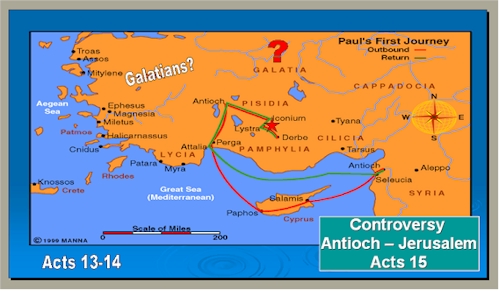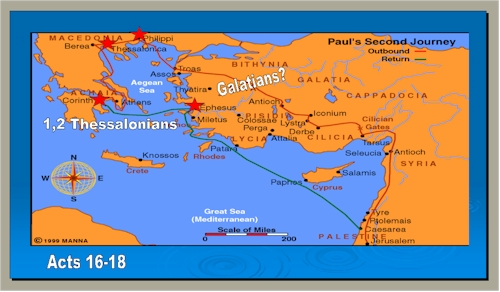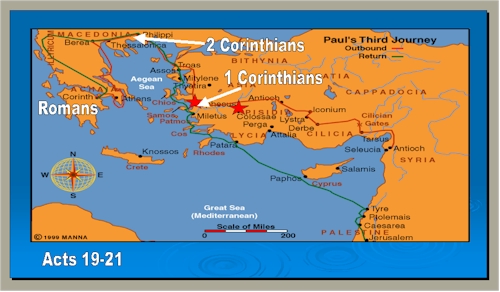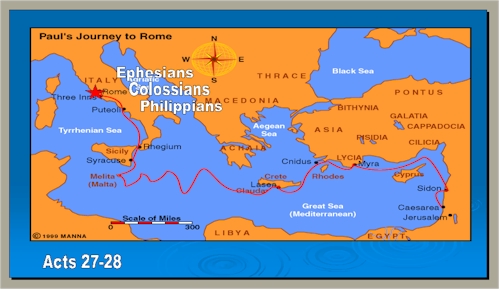|
Introduction:
It is interesting to notice all the different kinds of
teaching found in the letters Paul wrote to the
churches,
primarily as a result of his travels.
There are the problems in Corinth, the
great teaching in
Ephesus about the Church, and the teaching in Colosse about the
authority of Christ.
Where did these churches come from?
How did they get started?
When do the letters fit in?
A survey of Acts reveals the answers to these
questions. Discussion: I.
Paulís First Journey and the Jerusalem Council (Acts
13-15)
A.
Paul, accompanied by Barnabas, begins his first journey from Antioch B.
Island of Cyprus (two stops) 1.
Paul teaches the Roman ruler 2.
Paul overcomes opposition by striking a man with blindness C.
Iconium, Lystra, and Derbe 1.
This region is typically understood to be Galatia
(interesting, however, that the map calls this the region of
Cilicia, Pamphylia, and Pisidia, and Galatia is marked further
north) 2.
Paul preaches to the Gentiles D.
Paul and Barnabas return to Antioch 1.
Paul makes a report of the preaching among the Gentiles 2.
Men from Judea arrive stating the Gentiles must be
circumcised 3.
The apostles, elders, and brethren in Jerusalem would later
write a letter to the Gentile brethren in Antioch, Syria, and
Cilicia, devoted to the controversy over
circumcision E. Paul and Barnabas leave for Jerusalem to determine the source of the controversy II.
Paulís Second Journey (Acts
16-18)
A.
Paul, accompanied by Silas, begins his second journey from Antioch to
visit the churches where he had been before B.
They take with them the letter of resolution written at the
council in Jerusalem concerning the controversy over circumcision C.
Not sure when Paulís letter to the Galatians was written; the
language of the letter seems to suggest that the letter may have
been written shortly after his first journey D.
Paul receives a vision of a man from Macedonia requesting
help, which leads them to Philippi E.
Philippi 1.
Paul teaches and converts Lydia, and other women at the
river bank 2.
Paul casts a demon out of a young girl, which causes jealousy 3.
Paul and Silas go to court and are put in prison where Paul
teaches and converts a jailer 4.
Paul would later write a letter to the church at Philippi F.
Thessalonica 1.
Paul preaches for three Sabbaths 2.
Immediately, the response is good, but then jealousy causes
a very strong opposition 3.
Paul and Silas are forced to leave because their lives were
being threatened 4.
Paul would later write a letter to the church at Thessalonica G.
Berea 1.
The people in the town were more noble, in that they were
at least willing to listen 2.
Non-Christian Thessalonians arrive and stir up persecution
against Paul & Silas H.
Athens 1.
Paul preaches on Mars Hill I.
Corinth 1.
Paul stays with Aquila and Priscilla 2.
Paul writes a letter to the church at
Thessalonica, and a
second letter very soon after 3.
Paul would later write a letter to the church at Corinth J.
Ephesus 1.
Paul teaches for a short time and receives good results
before leaving for Jerusalem 2.
Aquila and Priscilla, who had accompanied Paul, stay behind
and they find Apollos, who ends up going back to Corinth 3. Paul would later write a letter to the church at Ephesus III.
Paulís Third Journey (Acts
19-21)
A.
Paul begins his third journey from Antioch B.
Ephesus 1.
Paul stays for over two years 2.
He meets disciples of Apollos who know only the baptism of
John 3.
He teaches them baptism into Christ 4.
He responds to news of problems at Corinth by writing a
strong letter to the church there C.
At or near Philippi on his way to Corinth 1.
A year after writing his first letter to the church at
Corinth, Paul writes a gentler second letter reminding them to
have their contribution for the needy saints in Judea ready by the
time he gets there D.
Corinth 1.
Paul writes a letter to the church at Rome about his plans
to visit them (and Aquila and Priscilla) for the first time, but
only after returning to Jerusalem E.
Troas 1.
Paul stays for seven days in order to meet with the brethren on the first day of the week
when they assembled to break
bread F.
Miletus 1.
Paul calls for and meets with the elders of the church at
Ephesus 2.
He talks with them about the church in Ephesus, the work
there, and how to deal appropriately and properly with troubles
that will most certainly arise 3.
He bids the elders farewell and leaves for Jerusalem with
the contribution for the needy saints there G.
Jerusalem 1.
Almost immediately, Paul is thrown into prison confirming
prior warnings of trouble should he return to Jerusalem 2. God reassures Paul that he will meet the brethren in Rome, because he must preach the gospel there IV.
Paulís Journey to Rome (Acts
27-28)
A.
Paul begins his journey to Rome from Caesarea B.
Rome 1.
Paul writes letters to the churches at
Ephesus, Colosse,
and Philippi 2.
These were the churches he had established ten years prior 3.
Paulís other letters: a.
1 Timothy Ė written from Roman prison b.
Titus Ė written from Roman prison Ö or possibly after
release from first imprisonment? c.
Philemon Ė written from Roman prison Ö a strong
connection with Colossians d. 2 Timothy Ė written from (2nd) Roman imprisonment Conclusion:
Paulís travels resulted in a great deal of teaching.
This survey of Acts gives us a setting against which to
place Paulís letters to the churches Ė messages from
God.
It helps us to visualize these churches as very real congregations that assembled to sing, pray, and listen to a speaker, and then the brethren would leave the assembly to do the work of their everyday lives. It helps us to become familiar with their circumstances and how they sat in the assembly, and to realize that the apostle Paul was one of the evangelists that taught and preached to these very real congregations.
Glory
to God in the church by Christ Jesus
|



